Heather Graham's Blog, page 3
May 7, 2013
30 Days of Why I Love New Orleans - Day 24
Bars, Booze, and Broads—Bourbon Street
Okay, let’s face it. NOLA is known for Bourbon Street and for “laissez les bon temps
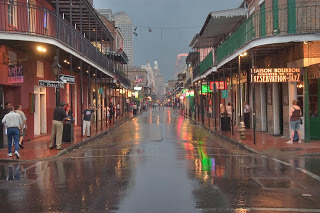 rouler,” or “let the good times roll!” While incredible, interesting, and historic bars can be found all over New Orleans, many a once innocent soul has spent the night just on and around famous—and infamous—Bourbon Street.
rouler,” or “let the good times roll!” While incredible, interesting, and historic bars can be found all over New Orleans, many a once innocent soul has spent the night just on and around famous—and infamous—Bourbon Street. People come from near and far for bachelor parties, birthday parties—especially that major leap of 21—and every other kind of party you can possible think of. I mean, that is, when New Orleans isn’t having a party to which the world is invited, and the city itself has all kinds of parties—remember Jazz Fest, French Quarter Fest, Mardi Gras, etc.
It’s where folks come to let loose and hang out and drop in on a bar or two. Or three or . . . .
Well, you get the drift.
But, you can have it your way, too. One of my most charming friends I’ve made in NOLA, an entertainer on Bourbon Street, has also been a member of AA for years and years—and he still has fun. So, try out some of NOLA’s cocktails, or watch the slightly inebriated while sober yourself, which, of course, can be just as much fun. It’s not always what you choose to drink but where you choose to go to drink-- whatever it is that you’ll drink--which is the fun.
Getting down and dirty.
 From the minute you start down Bourbon—say you’re strolling from Canal Street to Esplanade (toward Esplanade, you’ll start to find something of a residential section) you’ll see all manner of establishments vying for your tourist dollar. As you walk you come across establishment after establishment, bars and strip clubs. The beautiful hotel Royal Sonesta is at 300 Bourbon, and of course, it offers a bar, too. You’ll move on down and there will be a bar, and there will be a strip club—and then there will sometimes be people in the middle of the street warning you with big signs that say “Repent! Lest you go to hell,” or “God hates gays.” While I must admit it’s not like you’re preaching to the crowd here, I’m dying one day to go up to one of the redeeming souls and tell them that I’ve just spoken to God and God says that gays are just fine—He’s not sure about people in the middle of a street telling others how to live.
From the minute you start down Bourbon—say you’re strolling from Canal Street to Esplanade (toward Esplanade, you’ll start to find something of a residential section) you’ll see all manner of establishments vying for your tourist dollar. As you walk you come across establishment after establishment, bars and strip clubs. The beautiful hotel Royal Sonesta is at 300 Bourbon, and of course, it offers a bar, too. You’ll move on down and there will be a bar, and there will be a strip club—and then there will sometimes be people in the middle of the street warning you with big signs that say “Repent! Lest you go to hell,” or “God hates gays.” While I must admit it’s not like you’re preaching to the crowd here, I’m dying one day to go up to one of the redeeming souls and tell them that I’ve just spoken to God and God says that gays are just fine—He’s not sure about people in the middle of a street telling others how to live. Those holding the signs are often in front of a well-known strip club.
One day . . . .
Ah, wherever you go, you’ll hear music.
And it’s getting nice and varied again!
Right after the summer of storms, you could hear different lines of the same Journey song coming from many bars—they needed to try for what they thought was most commercial. Now, you’ll hear pop, rock, jazz, and blues. It’s all back.
A number of people will suggest that you see Pat O’Brien’s. I concur. The place has a great history. Pat O’Brien was running a speakeasy. When prohibition was lifted in the thirties, he went legitimate. So, Pat O’Brien’s has been serving legitimately since 1933. Many people go to Pat O’Brien’s to try out their famous Hurricane. We do prefer the drink to the storm. But
 there’s more to Pat O’Brien’s. They provide wonderful entertainment. My favorite part of Pat O’Brien’s is the courtyard. It is brick; it has scattered tables--it takes you off the craziness of Bourbon Street into a little sanctuary of craziness. It has a lovely fountain. If the temperature drops there are heaters.
there’s more to Pat O’Brien’s. They provide wonderful entertainment. My favorite part of Pat O’Brien’s is the courtyard. It is brick; it has scattered tables--it takes you off the craziness of Bourbon Street into a little sanctuary of craziness. It has a lovely fountain. If the temperature drops there are heaters. The entrance is actually at 718 St. Peter Street, but you walk down Bourbon and turn the corner and you’re there, but I love the bar so we’re counting it in.
Booze and broads. You’ll find them every few feet and I’m not going to try to list them all; you’ll want to go where a sign attracts you and decide if you’re favorite piece of a wild night or not. But, I’ll throw in a few!
 Want to ride a mechanical bull? That’s at Bourbon Cowboy. (241 Bourbon) What fun watching as others try to stay on—and what a contest if you’re up to it! What to sing karaoke? That’s down at the Cat’s Meow. (701 Bourbon Street) The Cat’s Meow is on the corner of St. Peter Street so you can easily hop from Pat O’Brien’s on over or vice-versa. They start nice and early—around five. There’s one karaoke song and a host song and a karaoke song and a host song . . . that gives the place time to make sure the next performer is on hand—and that he or she hasn’t wandered
Want to ride a mechanical bull? That’s at Bourbon Cowboy. (241 Bourbon) What fun watching as others try to stay on—and what a contest if you’re up to it! What to sing karaoke? That’s down at the Cat’s Meow. (701 Bourbon Street) The Cat’s Meow is on the corner of St. Peter Street so you can easily hop from Pat O’Brien’s on over or vice-versa. They start nice and early—around five. There’s one karaoke song and a host song and a karaoke song and a host song . . . that gives the place time to make sure the next performer is on hand—and that he or she hasn’t wandered 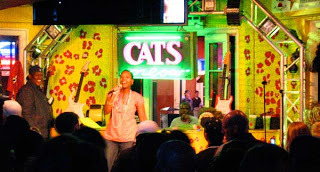 off down the street.
off down the street. Are you a beer lover? There’s Beer Fest at 409 Bourbon.
Bourbon Pub, Bourbon Oh!, Bourbon Street Blues Company. There is absolutely no way for you to walk down Bourbon and not find a pub that intrigues, a band that draws you in for the street—or a solicitor on the walk offering you a two-for-one deal that you can’t refuse.
Strip Clubs? Oh, there are plenty. Rick’s Cabaret, Larry Flynt’s Hustler’s Club, Penthouse, Barely Legal . . . the list goes on.

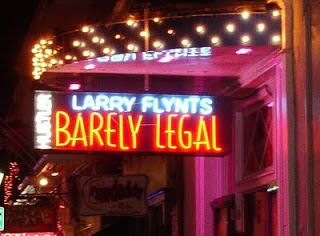 Burlesque? Stop by the see a show by the legendary Chris Owens at 500 Bourbon. Chris started her club in the 1960s and as I write this, she’s still going strong. Customers rave about the great time they’ve had there.
Burlesque? Stop by the see a show by the legendary Chris Owens at 500 Bourbon. Chris started her club in the 1960s and as I write this, she’s still going strong. Customers rave about the great time they’ve had there. Tropical Isle often offers a rock band I love. You’ll find it at Bourbon and Orleans or 721 Bourbon. They’re also the home of the “Hand Grenade.” Amazing how we love to come home with funny-shaped drinking vessels that we can refill. The same owners offer up the Funky Pirate—get your hand grenade there, too.
So thirty you can’t stand it? Entrepreneurs have ice-filled beer, etc., carts out in the street often enough, especially at really busy times.
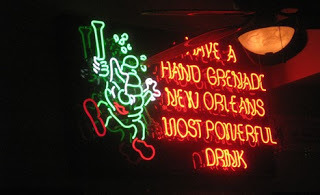 No one wants you to have to wait!
No one wants you to have to wait! A bit off Bourbon at 811 Conti is Erin Rose. Friends and I have met there many times. They offer excellent Irish beers and whiskey and more of course, have a nice and friendly staff, and it’s a place many of the locals head. They also have a little menu of food to go with your drinks.
Remember, too, Lafitte’s Blacksmith Shop and Bar is on Bourbon at 941. Throw a little history in with your bar-hopping.
You really can’t go by what I say. You have to explore.
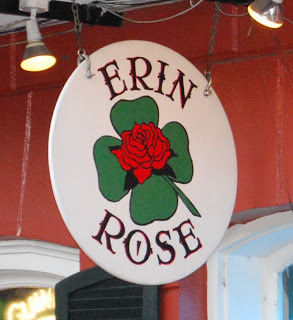 Everyone will have their favorite place to visit on Bourbon—or close off! Whether you’re a drinker or a teetotaler, gay or straight, male or female, any visitor should take at least one stroll down Bourbon.
Everyone will have their favorite place to visit on Bourbon—or close off! Whether you’re a drinker or a teetotaler, gay or straight, male or female, any visitor should take at least one stroll down Bourbon. And then, of course, some shudder at the thought of going near it.
But that’s something you have to decide for yourself.
It’s like an experience badge.
Ah, yes! I’ve walked down Bourbon Street . . . .
Published on May 07, 2013 21:31
April 26, 2013
30 Days of Why I Love New Orleans - Day 23
Ghosts!
It’s been a hot, sultry day. You’ve walked the city until nightfall and suddenly the air cools. The steam rises from the pavement and you’re walking in a field of mist by Jackson Square. And then you see him—a figure coming from the closed doors of the Cathedral. Perhaps he heads down one of the alleys that flank the Church, Pirate’s Alley or—Pere Antoine Alley.. He turns to look at you with gentle eyes, kindness and compassion—and then
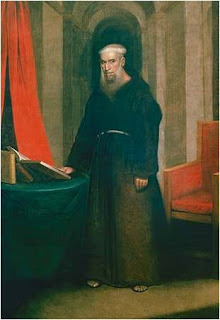 disappears. You’ve just met one of the famous ghosts of the city, Pere Antoine, born Antonio de Sedella in 1748. Pere Antoine has a mixed history—but then, you see, he was a real flesh and blood man who came to New Orleans under the Spanish Crown as part of the Spanish Inquisition that took place in Louisiana. And real human beings, we know, come with virtues and faults.At first, a man rigid in discipline, he quickly became a humanitarian. He had no heart for any kind of cruelty and instead, tended to the sick and dying, cared deeply for the slaves and freemen of every color. He risked his own health time and time again to render help to those suffering from disease.He is however, blamed by some for the Great Fire of 1788 that swept through the city—destroying 80% of the buildings, remember?—because it was Good Friday, and the Church dictated that bells not be rung on Good Friday. Whether he was directly to be blamed or not, the Church, as we know, burned to the ground and had to be rebuilt. That didn’t stop Pere Antoine. He stayed in New Orleans until his death in 1829, loved especially by the poor and revered by the slaves. If you encounter Pere Antoine—he also seemed to like misty mornings—you will usually feel a sense of peace and comfort.But, this city is full of ghosts. Seriously, please, of course! You don’t go through all the history and trauma faced by one of our most unique and wonderful cities without accruing ghosts. I never want to leave NOLA—why would the dead want to go?At 716 Dauphine Street, you will find another of NOLA’s more famous ghosts. The Sultan,
disappears. You’ve just met one of the famous ghosts of the city, Pere Antoine, born Antonio de Sedella in 1748. Pere Antoine has a mixed history—but then, you see, he was a real flesh and blood man who came to New Orleans under the Spanish Crown as part of the Spanish Inquisition that took place in Louisiana. And real human beings, we know, come with virtues and faults.At first, a man rigid in discipline, he quickly became a humanitarian. He had no heart for any kind of cruelty and instead, tended to the sick and dying, cared deeply for the slaves and freemen of every color. He risked his own health time and time again to render help to those suffering from disease.He is however, blamed by some for the Great Fire of 1788 that swept through the city—destroying 80% of the buildings, remember?—because it was Good Friday, and the Church dictated that bells not be rung on Good Friday. Whether he was directly to be blamed or not, the Church, as we know, burned to the ground and had to be rebuilt. That didn’t stop Pere Antoine. He stayed in New Orleans until his death in 1829, loved especially by the poor and revered by the slaves. If you encounter Pere Antoine—he also seemed to like misty mornings—you will usually feel a sense of peace and comfort.But, this city is full of ghosts. Seriously, please, of course! You don’t go through all the history and trauma faced by one of our most unique and wonderful cities without accruing ghosts. I never want to leave NOLA—why would the dead want to go?At 716 Dauphine Street, you will find another of NOLA’s more famous ghosts. The Sultan,  also known as Sultan Suleyman. The story begins with local Monsieur LaPrete, a once-wealthy plantation owner, who also had a city mansion on Delphine when the Union took over the city during the Civil War. Property owners scrambled to find a way not to go completely broke—their Confederate currency was worthless. In the city, seeking the advice of friends, LaPrete met a man at a pub who had overheard his tale of woe. The man introduced himself as an emissary of a Turkish sultan. The sultan had a huge family and needed a big house and the four stories at the corner of Orleans and Delphine seemed perfect. LaPrete checked out the sultan, found out he was incredibly wealthy, rented the house to the sultan and returned to his plantation.The sultan had a huge family indeed. Wives, concubines, and even little boys, so the story goes, and plenty of children. He also had a small army of eunuchs to guard the house; they stood upon the galleries, ever watchful. It’s rumored that people disappeared into the house—people as in beautiful young women of every shade. It was a tough time in NOLA, with “Beast” Butler ruling things, the war going this way and
also known as Sultan Suleyman. The story begins with local Monsieur LaPrete, a once-wealthy plantation owner, who also had a city mansion on Delphine when the Union took over the city during the Civil War. Property owners scrambled to find a way not to go completely broke—their Confederate currency was worthless. In the city, seeking the advice of friends, LaPrete met a man at a pub who had overheard his tale of woe. The man introduced himself as an emissary of a Turkish sultan. The sultan had a huge family and needed a big house and the four stories at the corner of Orleans and Delphine seemed perfect. LaPrete checked out the sultan, found out he was incredibly wealthy, rented the house to the sultan and returned to his plantation.The sultan had a huge family indeed. Wives, concubines, and even little boys, so the story goes, and plenty of children. He also had a small army of eunuchs to guard the house; they stood upon the galleries, ever watchful. It’s rumored that people disappeared into the house—people as in beautiful young women of every shade. It was a tough time in NOLA, with “Beast” Butler ruling things, the war going this way and 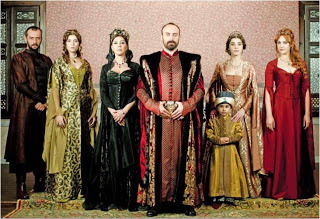 that—and it was hard to keep track of everyone.Two years went by. Then, a neighbor walking past the house paused because she didn’t hear any noise. This place where so many lived, where the sultan entertained lavishly and enjoyed his many partners had gone silent.Then . . . she saw it. Blood. Blood dripping from the gallery. When the police arrived, they discovered that there was more than blood everywhere—there were body parts everywhere. It was a nightmare. No one knew just how many people lived in the house, so it was difficult to put the body parts together and come up with an accurate count. One body, however, was mysteriously missing no matter how the parts were put together. That was the body of the Sultan, and he was eventually found in a shallow grave—one hand reaching through the earth. His lungs and throat were filled with dirt. In traditional Muslim funeral attire, he had
that—and it was hard to keep track of everyone.Two years went by. Then, a neighbor walking past the house paused because she didn’t hear any noise. This place where so many lived, where the sultan entertained lavishly and enjoyed his many partners had gone silent.Then . . . she saw it. Blood. Blood dripping from the gallery. When the police arrived, they discovered that there was more than blood everywhere—there were body parts everywhere. It was a nightmare. No one knew just how many people lived in the house, so it was difficult to put the body parts together and come up with an accurate count. One body, however, was mysteriously missing no matter how the parts were put together. That was the body of the Sultan, and he was eventually found in a shallow grave—one hand reaching through the earth. His lungs and throat were filled with dirt. In traditional Muslim funeral attire, he had 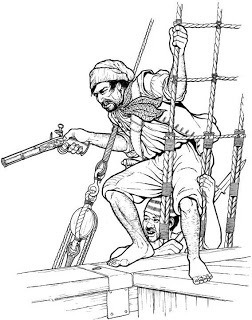 been buried alive.The horrible massacre was never prosecuted because culprits could not be caught. Blame the pirates! Ahoy, matey, and why not? Well, pirates were men of enterprise. They were fond of pistols and were known for killing their enemies with pistols or swords, but not cutting them into pieces. They liked women—women could be sold. And they were not known for the murder of children. But, for years, no one could think of anyone else to blame. Somewhere in history it was discovered that the Sultan wasn’t really a Sultan—he was the brother of the Sultan. Sometimes, the oldest son, the inheritor, was known to kill his siblings in order to make sure that an inheritance went directly to his oldest son. Was this what happened in New Orleans? Were assassins hired to carry out the grisly task, slipping in and out by the darkness of the night?No one knows. What they do know is that when the light in the city in misty, when morning first appears, when dusk takes claim, strange things may be seen at the Sultan’s house. Turkish guards appear on the gallery and sometimes passersby see a man in a turban and robes entering or leaving the house . . . or perhaps, they see when a hand reaches out of the dirt and the murdered man tries to dig his way back to the glory of the life he had so briefly known at the house on Dauphine.
been buried alive.The horrible massacre was never prosecuted because culprits could not be caught. Blame the pirates! Ahoy, matey, and why not? Well, pirates were men of enterprise. They were fond of pistols and were known for killing their enemies with pistols or swords, but not cutting them into pieces. They liked women—women could be sold. And they were not known for the murder of children. But, for years, no one could think of anyone else to blame. Somewhere in history it was discovered that the Sultan wasn’t really a Sultan—he was the brother of the Sultan. Sometimes, the oldest son, the inheritor, was known to kill his siblings in order to make sure that an inheritance went directly to his oldest son. Was this what happened in New Orleans? Were assassins hired to carry out the grisly task, slipping in and out by the darkness of the night?No one knows. What they do know is that when the light in the city in misty, when morning first appears, when dusk takes claim, strange things may be seen at the Sultan’s house. Turkish guards appear on the gallery and sometimes passersby see a man in a turban and robes entering or leaving the house . . . or perhaps, they see when a hand reaches out of the dirt and the murdered man tries to dig his way back to the glory of the life he had so briefly known at the house on Dauphine.
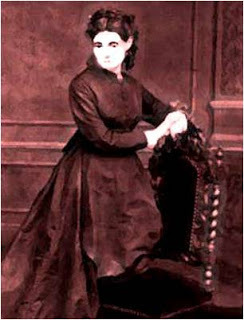 Perhaps the city’s most famous haunted house is that which once belonged to Madame LaLaurie. Oh, the things that woman was reported to do—the horrors she perpetuated on others! For more on Madame LaLaurie, please watch the video located here: http://www.writersforneworleans.com/s..., of course, you’re heading to New Orleans and want to experience all the wonderful tales for yourself! There are many ways to do this. The city thrives on its ghosts stories. Ghost? You wouldn’t say that as a bad thing—certainly not! Ghosts are part of the fabric and character of a city.So, first off—you can question carriage driver’s down on Decatur in front of Jackson Square and tell them you want some great history—and some great ghosts, too. Carriage drivers can be amazing guides and you can meet your mule, too, get to know the old boy, and enjoy a ride through the city.There are also a number of wonderful tour companies to call upon. They include but are not limited to Big Easy Tours, Haunted History Tours, Dixie Tours, and French Quarter Phantoms. You’ll find pamphlets on many of these tours all over the city. There really is no such thing as a “best” tour except as each tour happens for each person. We all know that tour guide can make or break a tour—and that it also depends on your willingness to be part of the magic of a ghost tour. If you want to plan ahead, just key in “New Orleans Ghost Tours” and choose what you see as the best. Tired from all the sight-seeing? Take the carriage tour!
Perhaps the city’s most famous haunted house is that which once belonged to Madame LaLaurie. Oh, the things that woman was reported to do—the horrors she perpetuated on others! For more on Madame LaLaurie, please watch the video located here: http://www.writersforneworleans.com/s..., of course, you’re heading to New Orleans and want to experience all the wonderful tales for yourself! There are many ways to do this. The city thrives on its ghosts stories. Ghost? You wouldn’t say that as a bad thing—certainly not! Ghosts are part of the fabric and character of a city.So, first off—you can question carriage driver’s down on Decatur in front of Jackson Square and tell them you want some great history—and some great ghosts, too. Carriage drivers can be amazing guides and you can meet your mule, too, get to know the old boy, and enjoy a ride through the city.There are also a number of wonderful tour companies to call upon. They include but are not limited to Big Easy Tours, Haunted History Tours, Dixie Tours, and French Quarter Phantoms. You’ll find pamphlets on many of these tours all over the city. There really is no such thing as a “best” tour except as each tour happens for each person. We all know that tour guide can make or break a tour—and that it also depends on your willingness to be part of the magic of a ghost tour. If you want to plan ahead, just key in “New Orleans Ghost Tours” and choose what you see as the best. Tired from all the sight-seeing? Take the carriage tour!
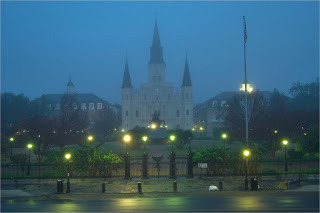 I couldn’t begin to introduce all the stories you’ll discover. This is New Orleans. A few cities do claim to be the most haunted. I promise you, New Orleans deserves to be in the top running!Pirates, yes . . . .Back to pirates!But for now . . . .You’re walking down the street. It’s very late at night and you’re far from the revelry of Bourbon Street. Before you, you see a woman in white and she is running, running down the
I couldn’t begin to introduce all the stories you’ll discover. This is New Orleans. A few cities do claim to be the most haunted. I promise you, New Orleans deserves to be in the top running!Pirates, yes . . . .Back to pirates!But for now . . . .You’re walking down the street. It’s very late at night and you’re far from the revelry of Bourbon Street. Before you, you see a woman in white and she is running, running down the street . . . you turn! A phantom carriage is racing toward the river carrying Madame and Doctor LaLaurie as they try to escape . . . .You run by Jackson Square. And it’s all cool again because gentle Pere Antoine is just leaving the Cathedral, reading his prayer book with his rosary in his hands, and he will comfort you!
Published on April 26, 2013 00:58
April 23, 2013
30 Days of Why I Love New Orleans - Day 22
Bayou Baby! “Ya seen one gator, ya seen ‘em all!” So said a visitor to NOLA I overheard one day.
 Hm. Okay, well, I’m from South Florida where, while I was growing up, it was a pretty common thing to get out in the Everglades. I’ve always loved our heritage here—heading out to Shark Valley where you’ll walk a path where there are snakes and birds and massive alligators and a wonderful tower where you can look out over our “river of grass.” I love visiting our Miccosukee villages and Big Cypress and the Seminole villages. Yes, an alligator is an alligator is an alligator. (Hey, down here, by the way, we have crocs, too, the only crocs in the Continental United States, other than the kind you put on
Hm. Okay, well, I’m from South Florida where, while I was growing up, it was a pretty common thing to get out in the Everglades. I’ve always loved our heritage here—heading out to Shark Valley where you’ll walk a path where there are snakes and birds and massive alligators and a wonderful tower where you can look out over our “river of grass.” I love visiting our Miccosukee villages and Big Cypress and the Seminole villages. Yes, an alligator is an alligator is an alligator. (Hey, down here, by the way, we have crocs, too, the only crocs in the Continental United States, other than the kind you put on  your feet.) But I promise you, swamp and airboat tours are different in different places. And in NOLA, you have several choices of getting out and enjoying nature! First of all, definitions can be confusing and lines can wobble. The tours are really of what are considered “wetlands.” Wetlands have bayous; bodies of water like creeks or small rivers that are tributaries of bigger rivers or bodies of water, swamps; seasonally flooded bottom lands with more trees than marshes; tracts of low wet lands with few to no trees but cattails, grasses, etc. When you’re visiting one, you’re probably close to another, and so, when you’re on a “swamp” tour, you’ll often see bayous and marshes as well as swamps. What’s spectacular to them all is the wildlife you’ll get to see.
your feet.) But I promise you, swamp and airboat tours are different in different places. And in NOLA, you have several choices of getting out and enjoying nature! First of all, definitions can be confusing and lines can wobble. The tours are really of what are considered “wetlands.” Wetlands have bayous; bodies of water like creeks or small rivers that are tributaries of bigger rivers or bodies of water, swamps; seasonally flooded bottom lands with more trees than marshes; tracts of low wet lands with few to no trees but cattails, grasses, etc. When you’re visiting one, you’re probably close to another, and so, when you’re on a “swamp” tour, you’ll often see bayous and marshes as well as swamps. What’s spectacular to them all is the wildlife you’ll get to see.
 Heading north of the city, you can visit Manchac Swamp. Naturally, you’ll have to check with tour guides on how to get out there—and how you want to see it. Manchac, you see, is horribly haunted. Manchac is where you’ll find “the blood-red hanging tree.” It’s where, in 1915, the Great West Indies Storm went through—creating a tidal wave of about 20 feet that killed over 300 people. Naturally, there was a voodoo curse, there’s a cemetery, a lost settlement, and—the rougarou. What’s a rougarou? Take a tour and they’ll tell you. No, nevermind, I’ll spill. The name comes from the French loup-garou. You can actually see the word written many ways now—Roux-ga-Roux, Rugaru, and more. But,
Heading north of the city, you can visit Manchac Swamp. Naturally, you’ll have to check with tour guides on how to get out there—and how you want to see it. Manchac, you see, is horribly haunted. Manchac is where you’ll find “the blood-red hanging tree.” It’s where, in 1915, the Great West Indies Storm went through—creating a tidal wave of about 20 feet that killed over 300 people. Naturally, there was a voodoo curse, there’s a cemetery, a lost settlement, and—the rougarou. What’s a rougarou? Take a tour and they’ll tell you. No, nevermind, I’ll spill. The name comes from the French loup-garou. You can actually see the word written many ways now—Roux-ga-Roux, Rugaru, and more. But, 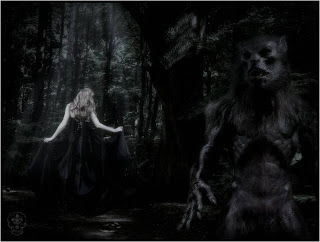 you’ve probably guessed it. Originally, we’re talking French werewolf here. Wolves are not at common in the swamp area, but a host of other animals are, so the rougarou may take on a variety of forms. The legend—as it was in Europe—has become pure Louisiana here. Being bitten by a rougarou is not an instant death-warrant; there are good endings and bad endings to encounters with rougarous. If you take a tour, your director can tell you what you must—and must not do!—should you encounter a rougarou. In the mid-eighteen hundreds, there were about 1200 people living in the area growing mainly cabbages and black-eye peas. They all knew one another, and when the train went through from NOLA to Jackson Mississippi in 1856, the vegetables grown here became prized all over the nation. People
you’ve probably guessed it. Originally, we’re talking French werewolf here. Wolves are not at common in the swamp area, but a host of other animals are, so the rougarou may take on a variety of forms. The legend—as it was in Europe—has become pure Louisiana here. Being bitten by a rougarou is not an instant death-warrant; there are good endings and bad endings to encounters with rougarous. If you take a tour, your director can tell you what you must—and must not do!—should you encounter a rougarou. In the mid-eighteen hundreds, there were about 1200 people living in the area growing mainly cabbages and black-eye peas. They all knew one another, and when the train went through from NOLA to Jackson Mississippi in 1856, the vegetables grown here became prized all over the nation. People  knew one another and cared about one another. One famous resident was Aunt Julia Brown—she lived in the small settlement of Frenier. Creole and something of a voodoo priestess, Aunt Julia was to take her last breath the day before the devastating hurricane rolled in and she so loved her land and people that she prophesized that they would all die with her. The storm didn’t kill them all, but it did take approximately 300 people the next day. There are great tales of heroism here. A train engineer who knew the local residents determined to get some of them out. While the train had been ordered to cease running, he took the engine and a few box cars, trying to get in and get people out. He had twenty-two souls aboard before he could go no further. The storm swept in, the boxcar flooded—but! The next day, the water went down and he and those he saved walked back to survive. It’s a story of heroism that’s real—history is always better than anything we can make up! I have to say that you can head out, have an amazing Cajun meal at a “campsite” there, and then take a night tour and hear these stories told in the right atmosphere and by
knew one another and cared about one another. One famous resident was Aunt Julia Brown—she lived in the small settlement of Frenier. Creole and something of a voodoo priestess, Aunt Julia was to take her last breath the day before the devastating hurricane rolled in and she so loved her land and people that she prophesized that they would all die with her. The storm didn’t kill them all, but it did take approximately 300 people the next day. There are great tales of heroism here. A train engineer who knew the local residents determined to get some of them out. While the train had been ordered to cease running, he took the engine and a few box cars, trying to get in and get people out. He had twenty-two souls aboard before he could go no further. The storm swept in, the boxcar flooded—but! The next day, the water went down and he and those he saved walked back to survive. It’s a story of heroism that’s real—history is always better than anything we can make up! I have to say that you can head out, have an amazing Cajun meal at a “campsite” there, and then take a night tour and hear these stories told in the right atmosphere and by 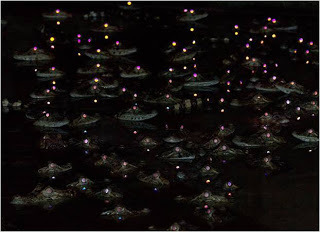 guides who know them backwards and forward. And there are more ghost stories, of course. And nature. Put them together and-- spooky. At night, you see the red eyes of alligators as they peer at you from the water. Seriously—I’m not sure if movie magic has ever created a creature like a gator with glowing eyes at night. But, while the stories are heart breaking and can make you believe in ghosts, the nature in the tours in amazing. There are a number of places to call or see about swamp tours, and I don’t want to be prejudice toward one or against any. Key in Louisiana Bayou Tours and you’ll find a number of different companies. Make sure you read up on what each one offers. Tours out of NOLA tend to be good—people really love their history and their place and most often, your tour guides are from the area and sometimes, their families have been there for decades—or even centuries. (Even if your guide happens to have come from somewhere else originally; they’ve been bitten by the love of the area!)
guides who know them backwards and forward. And there are more ghost stories, of course. And nature. Put them together and-- spooky. At night, you see the red eyes of alligators as they peer at you from the water. Seriously—I’m not sure if movie magic has ever created a creature like a gator with glowing eyes at night. But, while the stories are heart breaking and can make you believe in ghosts, the nature in the tours in amazing. There are a number of places to call or see about swamp tours, and I don’t want to be prejudice toward one or against any. Key in Louisiana Bayou Tours and you’ll find a number of different companies. Make sure you read up on what each one offers. Tours out of NOLA tend to be good—people really love their history and their place and most often, your tour guides are from the area and sometimes, their families have been there for decades—or even centuries. (Even if your guide happens to have come from somewhere else originally; they’ve been bitten by the love of the area!)
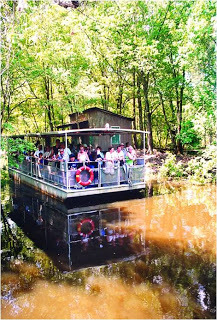 Now, if you’re not heading in the direction of Manchac Swamp, you might want to go south across the Mississippi River to the Jean Lafitte/Barataria preserve. This is where the famous and infamous pirate hid his booty. It was his home turf, so to say, and it’s deep in Cajun country. Naturally, there are wonderful stories to discover this side, too. There’s an old Native American burial mound here that is estimated to be about two-thousand years old. You can see what a Cajun fishing village is like and if you’re lucky, you might catch a glimpse of Miss Vicki. Miss Vicki is huge and old—she’s the undisputed Alligator Queen of Bayou Barataria. You can also take an airboat tour in this area. Zipping over the wetlands is exciting—and it’s also great when your captain slows or stops to relate a story or point out wildlife that is lurking. Many of the guides are natives to the area and have great and amazing tales to tell. The Barataria Preserve is part of the Jean Lafitte National Historical Park service. As always, remember with a national park that tours are set up so that people learn, look, and enjoy—and leave what it is as it is!
Now, if you’re not heading in the direction of Manchac Swamp, you might want to go south across the Mississippi River to the Jean Lafitte/Barataria preserve. This is where the famous and infamous pirate hid his booty. It was his home turf, so to say, and it’s deep in Cajun country. Naturally, there are wonderful stories to discover this side, too. There’s an old Native American burial mound here that is estimated to be about two-thousand years old. You can see what a Cajun fishing village is like and if you’re lucky, you might catch a glimpse of Miss Vicki. Miss Vicki is huge and old—she’s the undisputed Alligator Queen of Bayou Barataria. You can also take an airboat tour in this area. Zipping over the wetlands is exciting—and it’s also great when your captain slows or stops to relate a story or point out wildlife that is lurking. Many of the guides are natives to the area and have great and amazing tales to tell. The Barataria Preserve is part of the Jean Lafitte National Historical Park service. As always, remember with a national park that tours are set up so that people learn, look, and enjoy—and leave what it is as it is!
Published on April 23, 2013 15:06
30 Days of Why I Love New Orleans - Day 21
Pirates!
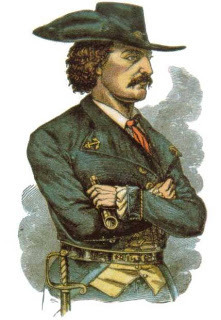
The pirate Jean Lafitte became more famous for joining Andrew Jackson to become a hero of the Battle of New Orleans than he was a pirate. (The French spelling of his name was Laffitte and he didn’t even come through Ellis Island, but in America it became Lafitte and with the number of places named after him now, hopefully he’d just go with it!) Everywhere you go in New Orleans—and in much of Louisiana—you can be reminded of Jean Lafitte.
Lafitte once claimed to have been born in Bordeaux, France. His brother, Pierre, claimed to have been born in Bayonne. Several of the pairs biographers have claimed that they were born anywhere from upstate New York to Saint Dominique, in what is now Haiti, and there are a few who suggest a small city in Spain and some who say maybe even New Orleans. You’d think he’d know where he was born—except that claiming to be a French
 citizen was helpful when dealing with American laws.
citizen was helpful when dealing with American laws. So, he was born somewhere in the world sometime around the year 1782. By the late 1790s, his brother, Pierre, was in Saint Dominique and Jean was most likely with him. Due to the violence of the Haitian Revolution, they left—and came over to New Orleans.
In 1803, the Louisiana Purchase made New Orleans an American city and in 1808, the country began seriously enforcing the Embargo Act of 1807. They’d been traders, really, until that point, dealing with the Caribbean countries and supplying New Orleans merchants with the goods they’d needed.
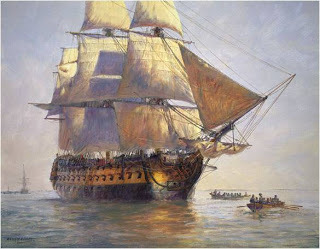 Off they went to Barataria Island which was sparsely settled and not easily accessible by the American navy. Here they set up their own little kingdom, essentially. They began their life of piracy with first one ship and then another, and soon they were rolling in ships and ill-gotten goods.
Off they went to Barataria Island which was sparsely settled and not easily accessible by the American navy. Here they set up their own little kingdom, essentially. They began their life of piracy with first one ship and then another, and soon they were rolling in ships and ill-gotten goods.Is there such a thing as a good pirate? Well, the Lafitte brothers were known for treating captives decently; after taking the goods, they sometimes even returned ships to their crews.
The merchants of New Orleans were fond of the pirates. Without the pirates, they wouldn’t have any merchandise.
Eventually, Governor Claiborne became furious with the situation; he posted handbills across New Orleans and in newspapers posting a 500 dollar reward for Lafitte.
 (Big bucks in those days.) But Lafitte was loved; the next day, handbills posting a higher ransom for Governor Claiborne appeared all over the city.
(Big bucks in those days.) But Lafitte was loved; the next day, handbills posting a higher ransom for Governor Claiborne appeared all over the city.The Lafitte brothers had been very successful holding auctions of their goods at the Temple (the prehistoric mound/ancient burial ground you can now visit at Jean Lafitte National Historic Park) on Barataria. War was brewing.
The Americans feared the pirates would side with the British. The British feared that the pirates would join up with the Americans.
Governor Claiborne sent troops out to Barataria. The pirates knew they were coming, burned some of their own ships, and fled. But ships were taken, goods were seized—and Jean escaped. He later wrote a letter to the governor; he still had ships. He knew the Americans wanted him. However, it was hard to come to terms when his brother was in jail.
Pierre most mysteriously escaped right after the letter was received.
It was time for . . . a pardon, a truce—a way to save the day.
By the war of 1812, the Americans were a little bit desperate. Britain—huge navy, queen of the seas. America—new nation, tiny navy, struggling to gain a position of authority against the country from which they had just broken.
Letters of marque were offered; this meant the navy was going to hire privately owned armed ships. This was a great chance for a pirate to become a privateer—and receive a pardon.
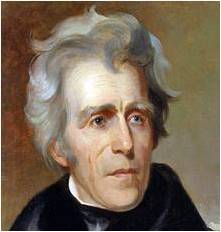 Andrew Jackson arrived in NOLA on December 1st, 1814. There were about a 1,000 raw troops at his disposal, and nothing much of a defense for the city.
Andrew Jackson arrived in NOLA on December 1st, 1814. There were about a 1,000 raw troops at his disposal, and nothing much of a defense for the city. Jean Lafitte met with Jackson in the city in mid-December. Lafitte’s deal was simple; his men would serve if Jackson would pardon every man who served in the defense of the United States with him. Jackson was a shrewd military leader; when Lafitte noted that the defensive line was short and the British ships might encircle the Americans, Jackson had the line extended. This move assured American success; two of his men were the first to fire on the British—on that extended line.
Yeah! We won. Okay, no one in NOLA had known that the war had already officially ended. What the battle proved was that the United States could—and would—fight a naval war.
Soon after, the Lafitte brothers moved on to Galveston, Texas. There was some pirate-ing in there, some spying for the Spanish government—and even some protecting of American ships again. He was wounded in battle and it’s believed that he died of those wounds and was buried at sea somewhere in Honduras Bay, February 5th, 1823.
He had forever left his mark in NOLA, Louisiana, and yes, the United States.
As mentioned earlier, you can visit the Barataria preserve. Wonderful trip! In the city, right in the French Quarter, you can head to Lafitte’s Blacksmith Shop and Bar. It’s on the corner of Bourbon and St. Philip. Built between 1722 and 1732 by Nicholas Touze, it’s
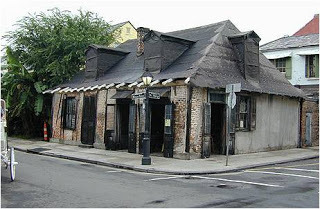 now supposed to be the oldest structure in the country operated as a bar.
now supposed to be the oldest structure in the country operated as a bar. It’s believed that the Lafitte Brothers used the place many years in the late 1700s for their smuggling operations for the city. Much of what we know is legend that gets a little more embellished every year, but this was the perfect place for people to meet. A rich man on Royal wouldn’t want to talk business with a pirate in his parlor, and here, at 941 Bourbon Street, “sales staff” and merchants could easily meet on what would have been considered “neutral” ground.
I enjoy coming here; it’s once again something that I really love—living history. It’s not a blacksmith shop at all, of course, but a lively bar. I like to just touch the walls and try to imagine life in the late 1700s. There’s a courtyard, and in all, you still have that wonderful feeling of the world here being casual. Yes! It’s nearly three-hundred years old. Sit down, have a drink, cool off. Wander into the courtyard.
 You can also wander to Café’ Lafitte in Exile (901 Bourbon Street,) the oldest continually operating gay bar in North America, and no one really cares what your sexual preference might be. Get your literary cloak on—Tennessee Williams and Truman Capote were known to stop by for a libation. Café’ Lafitte in Exile offers “Yappy Hour” from 3:00 to 5:00 so that your canine friends can do some bar-hopping as well.
You can also wander to Café’ Lafitte in Exile (901 Bourbon Street,) the oldest continually operating gay bar in North America, and no one really cares what your sexual preference might be. Get your literary cloak on—Tennessee Williams and Truman Capote were known to stop by for a libation. Café’ Lafitte in Exile offers “Yappy Hour” from 3:00 to 5:00 so that your canine friends can do some bar-hopping as well. The Lafitte Guest House and Gallery is just down at 1003 Bourbon Street. Once you get down this far, it’s quieter. The guest house is historic and beautiful. The guest house was built as a private home in 1849. One of the nice amenities here for an extended stay is that there is a full self-service kitchen
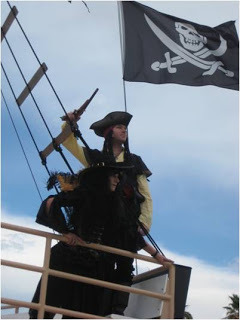 here. Check her out on-line!
here. Check her out on-line!You might want to give the elder Lafitte brother a boost and opt to head just out of the French Quarter—still close, easy walking distance--and stay at Maison Pierre Lafitte. Bedrooms are often little suites; the only complaint I’ve ever heard is that the bathrooms are small, but even then, beautifully appointed.
You will find the Lafitte name over and over again—and as I said, there’s nothing like a tour out to the national park on so many levels. The history is far richer than I ever begin to tell in this space and so much fun to explore on your own.
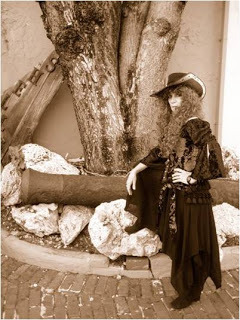
Arrgh!
Ahoy Matey.
Pirates! Yes, NOLA has them!
Published on April 23, 2013 14:22
April 20, 2013
30 Days of Why I Love New Orleans - Day 20
Jackson Square, The Cabildo, The Cathedral, and the Presbytere A picture speaks a thousand words, as we all know. No picture of New Orleans
 seems to speak quite as elegantly of the historical city as that of Jackson Square with the beautiful St. Louis Cathedral rising behind the famous statue of Andrew Jackson mounted on his rearing steed. As I write “why I love” today, I’m just back from NOLA. And I realized that it really is my home away from home and that I’m there so often, I didn’t actually start at a great place to begin—the heart of the French Quarter. Jackson Square. And it goes waaaay, way back.In Colonial days, of course, you had to have a place for men to practice defense. So, two things were decided the minute the French first chose their “high” ground where New Orleans would come to be--there should be a churchset on the land and a place to practice arms. Let's remember the whole Louisiana experience. The New World was being
seems to speak quite as elegantly of the historical city as that of Jackson Square with the beautiful St. Louis Cathedral rising behind the famous statue of Andrew Jackson mounted on his rearing steed. As I write “why I love” today, I’m just back from NOLA. And I realized that it really is my home away from home and that I’m there so often, I didn’t actually start at a great place to begin—the heart of the French Quarter. Jackson Square. And it goes waaaay, way back.In Colonial days, of course, you had to have a place for men to practice defense. So, two things were decided the minute the French first chose their “high” ground where New Orleans would come to be--there should be a churchset on the land and a place to practice arms. Let's remember the whole Louisiana experience. The New World was being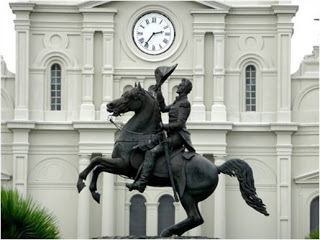 colonized. Europeans came to the Western hemisphere. In Louisiana, those who came first were French, we know. The stretch of land where the military men and/or home guard were to drill at arms was called the Place d’Armes and before any land was designated as anything, it was known there would immediately be a church and a plot of land, or common square, for the armed forces/home guard to drill. The church would be named for France’s canonized king, Saint Louis. (Naturally, the statue in now-Jackson Square-and-was-Place d’Armes would come later!)
colonized. Europeans came to the Western hemisphere. In Louisiana, those who came first were French, we know. The stretch of land where the military men and/or home guard were to drill at arms was called the Place d’Armes and before any land was designated as anything, it was known there would immediately be a church and a plot of land, or common square, for the armed forces/home guard to drill. The church would be named for France’s canonized king, Saint Louis. (Naturally, the statue in now-Jackson Square-and-was-Place d’Armes would come later!)
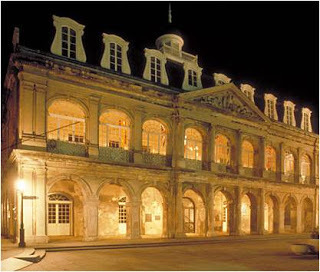 St. Louis, as it stands now, has not been there for ever and ever. But the place where the church would be was determined immediately. People have worshiped on the site of the current St. Louis since the first church was dedicated in 1727. But, in 1788, a fire started in the area when draperies caught fire and the church and other buildings in the area were just about charred flat. A new church was completed in 1794. Slowly, that church grew. A clock was brought from Paris along with a bell. Pieces were added. A major restoration began with the dearly rememberd Baroness Pontalba. In 1844, she set into motion the rebuilding of the structures left to her—the Pontalba buildings that flank the square. She also put forth plans to create buildings that would compliment the Cabildo, the Presbytere, and the Cathedral, and added plans to donate funds for desperately needed restructuring of the Cathedral. It wasn’t to be easy. People were hired and fired; walls that should have stood collapsed. But,
St. Louis, as it stands now, has not been there for ever and ever. But the place where the church would be was determined immediately. People have worshiped on the site of the current St. Louis since the first church was dedicated in 1727. But, in 1788, a fire started in the area when draperies caught fire and the church and other buildings in the area were just about charred flat. A new church was completed in 1794. Slowly, that church grew. A clock was brought from Paris along with a bell. Pieces were added. A major restoration began with the dearly rememberd Baroness Pontalba. In 1844, she set into motion the rebuilding of the structures left to her—the Pontalba buildings that flank the square. She also put forth plans to create buildings that would compliment the Cabildo, the Presbytere, and the Cathedral, and added plans to donate funds for desperately needed restructuring of the Cathedral. It wasn’t to be easy. People were hired and fired; walls that should have stood collapsed. But,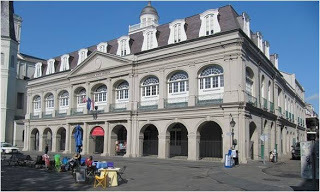 finally, after years went by, the beautiful Cathedral became what it is today—the grand Dame of the Square, ever looking over the green with its three towering steeples and magnificent facade. I’ve really touched just briefly on the history. If you’re going, don’t miss the Cathedral. I love St. Louis. I grew up with the—as my family lovingly called itself—off-the-potato-boat Irish, so I grew up with Catholic inclinations and my faith continues to be what I consider practicing Catholic—yes, I’m practicing. Don’t have it all right, but . . . going to St. Louis is an awesome experience for me! But, you don’t have to be Catholic or of any faith to enjoy the architecture and the treasures within; just remember that it remains an active Cathedral with a large congregation. Walk the steps that Andrew Jackson walked, visiting twenty-five
finally, after years went by, the beautiful Cathedral became what it is today—the grand Dame of the Square, ever looking over the green with its three towering steeples and magnificent facade. I’ve really touched just briefly on the history. If you’re going, don’t miss the Cathedral. I love St. Louis. I grew up with the—as my family lovingly called itself—off-the-potato-boat Irish, so I grew up with Catholic inclinations and my faith continues to be what I consider practicing Catholic—yes, I’m practicing. Don’t have it all right, but . . . going to St. Louis is an awesome experience for me! But, you don’t have to be Catholic or of any faith to enjoy the architecture and the treasures within; just remember that it remains an active Cathedral with a large congregation. Walk the steps that Andrew Jackson walked, visiting twenty-five 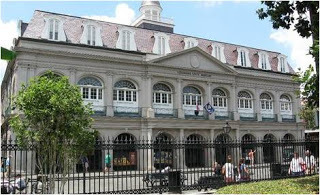 years after his triumph over the British!Facing the Cathedral, to your left, you’ll see the Cabildo. It was built in 1795. It served as the capital for the Spanish legislative assembly and then as City Hall. From 1853 until 1911, it housed the Louisiana Supreme Court. Now, it’s a museum, a flagship property of the Louisiana State Museum. It’s chock full of history which makes a lot of sense—it’s a very historic building.Facing the Cathedral and to your right is the Presbytere—built between 1794 and 1814. A government building as well, it served as a courthouse until 1911.And now, like the Cabildo, it’s part of the Louisiana State museum.There are museums I really suggest to see—you’ll get an amazing sense of why New Orleans (and Louisiana) is different. Their laws remain “Napoleonic,” and their way of life was influence by many flags—French, Spanish, French, American, Confederate, and American again. Get a sense of the lifestyle of the people there. See what the people went through from
years after his triumph over the British!Facing the Cathedral, to your left, you’ll see the Cabildo. It was built in 1795. It served as the capital for the Spanish legislative assembly and then as City Hall. From 1853 until 1911, it housed the Louisiana Supreme Court. Now, it’s a museum, a flagship property of the Louisiana State Museum. It’s chock full of history which makes a lot of sense—it’s a very historic building.Facing the Cathedral and to your right is the Presbytere—built between 1794 and 1814. A government building as well, it served as a courthouse until 1911.And now, like the Cabildo, it’s part of the Louisiana State museum.There are museums I really suggest to see—you’ll get an amazing sense of why New Orleans (and Louisiana) is different. Their laws remain “Napoleonic,” and their way of life was influence by many flags—French, Spanish, French, American, Confederate, and American again. Get a sense of the lifestyle of the people there. See what the people went through from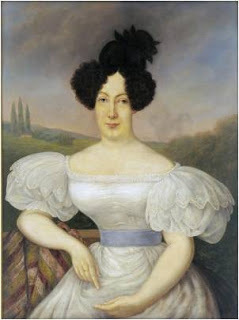 finding high ground in the great Crescent City and founding a colony, to wars and reconstruction, and into the present; they do have changing exhibits and have presented the “Summer of Storms” with heartbreaking clarity, honesty, and human interest.We’ll go back to Baroness Pontalba. She remains revered with good reason; she liked to use her money for the common good, to push forward through the red tape of her day, and create beautiful things. I’m sure it’s lovely to get to do this if you inherited your money, but, hey—she liked to put hers to good use and she did. Now, on the ground floors of these buildings, you’ll find a variety of shops and restaurants. The upper floor house apartments—as they were originally planned. The Pontalba Buildings, the Cabildo, the Cathedral, and the Presbytere all create the horse shoe around the Square.The Square itself! Well, you have the statue of Andrew Jackson. And grass and paths and benches and it’s just lovely. You can lie in that grass and look up at the sky or pose—as a host before you!—with Andy at his statue. In front of the Square, you’ll find artists hanging their work “on the
finding high ground in the great Crescent City and founding a colony, to wars and reconstruction, and into the present; they do have changing exhibits and have presented the “Summer of Storms” with heartbreaking clarity, honesty, and human interest.We’ll go back to Baroness Pontalba. She remains revered with good reason; she liked to use her money for the common good, to push forward through the red tape of her day, and create beautiful things. I’m sure it’s lovely to get to do this if you inherited your money, but, hey—she liked to put hers to good use and she did. Now, on the ground floors of these buildings, you’ll find a variety of shops and restaurants. The upper floor house apartments—as they were originally planned. The Pontalba Buildings, the Cabildo, the Cathedral, and the Presbytere all create the horse shoe around the Square.The Square itself! Well, you have the statue of Andrew Jackson. And grass and paths and benches and it’s just lovely. You can lie in that grass and look up at the sky or pose—as a host before you!—with Andy at his statue. In front of the Square, you’ll find artists hanging their work “on the 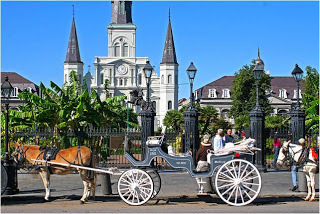 fence.” And there, in front, on Decatur Street, you’ll find the mule-drawn carriages waiting to take you around the French Quarter, with guides who love the history or the city and the ghosts of the city—and are happy to share one or the other of both. (Ghosts need good history, you know!)Here, too, along the walks, between the Cathedral and the green, you’ll find all kinds of performers. Musicians, creatures, beings, human statues and more. No two days will ever be the same. It’s the heart of the French Quarter. And you can feel its pulse!
fence.” And there, in front, on Decatur Street, you’ll find the mule-drawn carriages waiting to take you around the French Quarter, with guides who love the history or the city and the ghosts of the city—and are happy to share one or the other of both. (Ghosts need good history, you know!)Here, too, along the walks, between the Cathedral and the green, you’ll find all kinds of performers. Musicians, creatures, beings, human statues and more. No two days will ever be the same. It’s the heart of the French Quarter. And you can feel its pulse!
Published on April 20, 2013 23:38
April 18, 2013
30 Days of Why I Love New Orleans - Day 19
Blue Dog—Red Dog, Yellow Dog—and Art! Every so often a musician, an artist, a filmmaker, or writer creates a piece that just has a spark of something special, magical perhaps. Sometimes, those creators touch an age
 group, the angst in life, the feel of true romance, the pain of loss or war . . . or even a smile.
group, the angst in life, the feel of true romance, the pain of loss or war . . . or even a smile. It’s always hard to explain. And any art form is subjective. My cup of tea is your poison, or your raw onions are delicious to me. I happen to be in love with Blue Dog—and I’m certainly not alone. Blue Dog has become iconic in New Orleans. With good reason. Artist George Rodrique was born in New Iberia (where he also has a studio) in 1944. He studied in Louisiana and in Los Angeles, learning the nuts and bolts of drawing and painting. Since my artistic talent is somewhere between and nil and none, I don’t know a great deal about shade and shadow, brush strokes, or the many things art connoisseurs do know. But I know what I like—and I know that it makes me smile. My sister, Vickie, had a lot to do with
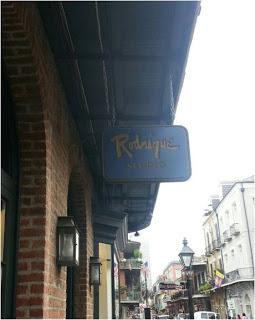 introducing me to the Blue Dog. Vickie and her friends at Delta Airlines religiously attended Jazz Fest and she was the first to fall in love with the Blue Dog. She bought a print at the Rodrique Studio on Royal Street. There’s just something in the dog’s expression that’s wonderful.
introducing me to the Blue Dog. Vickie and her friends at Delta Airlines religiously attended Jazz Fest and she was the first to fall in love with the Blue Dog. She bought a print at the Rodrique Studio on Royal Street. There’s just something in the dog’s expression that’s wonderful. Rodrique made use of his home in his art; he depicted Cajun life and history. He’s well known for creating atmosphere and a certain kind of spell. He has created images that incorporate the past and the present with ghosts appearing in the landscape he knows so well. Blue Dog began as a ghost dog in a grayish blue color with red eyes. But Blue Dog was a ghost—or modeled after Rodrique’s Tiffany, a pet he had lost long before painting his first image. Now, you don’t have to go to the studio to see Blue Dog; Blue Dog is iconic. Paintings and prints featuring Blue Dog can be seen in restaurants and hotels and other venues throughout the city. But if you discover that you love Blue Dog and have to get a little closer, you’ll have to
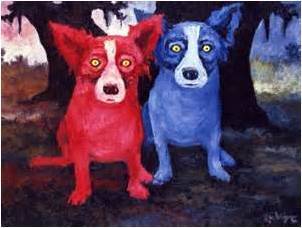 stop by the studio. It’s easy to do. You’ll now find it on Royal Street at number 730. You can also head to Lafayette, Louisiana, or Carmel, California.
stop by the studio. It’s easy to do. You’ll now find it on Royal Street at number 730. You can also head to Lafayette, Louisiana, or Carmel, California.Blue Dog is featured in books and has been pictured with many famous people in the arts, sports, and politics. My one and only foray into buying real art was a small signed print for my sister, and since then, every trip I take means a stop by at the studio. Just as Twilight touched upon teen-aged angst and falling in love, just as the Mona Lisa follows others, and just as the song “Memories” reminds us all of what being young and filled with hope was like, Blue Dog touches something in us. Blue Dog can bring a smile, maybe remind us of a beloved pet long gone, or just brighten the day somehow. Now, of course, I’ve gone on and on about Blue Dog. All of Rodrique’s art is special, haunting, intriguing, and touched with something very real—even when reality is in the form of ghosts. I have never met George Rodrique—I’m willing to bet I’d really like the man! There’s just something about that dog . . . . (Not to take a thing away from his other wonderful work!) Beyond Blue Dog and Rodrique, New Orleans remains a mecca for all kinds of art.
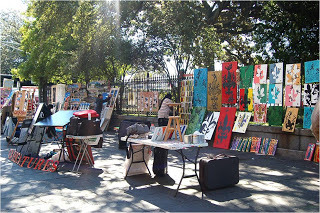 The new and upcoming artists can easily be found on Jackson Square. You’ll find all forms—sketches, paintings, mixed media, caricature artists and more. You can find images that capture the magic of the city, the elegance, the age, the decay, the restoration. A friend told me that an artist is pulled to the city—just like a writer. While writers use words to relay the heart and essence and atmosphere of the city, artists long to do so with their pens, pencils, and paints.
The new and upcoming artists can easily be found on Jackson Square. You’ll find all forms—sketches, paintings, mixed media, caricature artists and more. You can find images that capture the magic of the city, the elegance, the age, the decay, the restoration. A friend told me that an artist is pulled to the city—just like a writer. While writers use words to relay the heart and essence and atmosphere of the city, artists long to do so with their pens, pencils, and paints. Royal Street is known for its art shops but there are many scattered throughout the French Quarter and the city. You’ll find estate paintings, older pieces, and works by well-known masters. If contemporary art is special to you, you may want to take a trip to Julia Street in the Warehouse/Art District but if you’re fascinated by a stunning trip from gallery to gallery, just take a look at the many
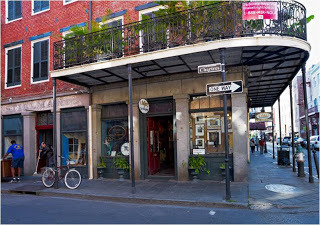 places on Royal. They are heavily conglomerated between the 300 and 800 blocks which allows for a really charming walk. Just a few to take in include Joe Dunn Arts, Mann Gallery, Gallerie Gauche Rive, Gallerie d’Art Francais, Elliott Gallery, and Kako Gallery. That’s naming just a few!
places on Royal. They are heavily conglomerated between the 300 and 800 blocks which allows for a really charming walk. Just a few to take in include Joe Dunn Arts, Mann Gallery, Gallerie Gauche Rive, Gallerie d’Art Francais, Elliott Gallery, and Kako Gallery. That’s naming just a few!As you pass fantastic street performers, you’ll also see fantastic artists along the way. It’s a way of life in New Orleans; it’s everywhere! One more particular favorite of mine is the Craig Tracy Gallery, 827 Royal
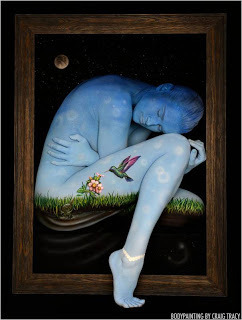 Street. I’ve never seen such amazing work. The artist—Craig Tracy, born and bred in NOLA--paints on bodies. In the most beguiling manner, he uses the human form along with his brush and imagination to create some of the most unusual and visually stunning pieces I’ve ever seen. You’ll be staring at an amazing leopard and realize that it’s perfectly painted on a human body. Obviously, what you see on the walls is worracyk in a mixed media—but I promise you, you’ll be amazed. You can look up some of the incredible work at craigtracy.com.
Street. I’ve never seen such amazing work. The artist—Craig Tracy, born and bred in NOLA--paints on bodies. In the most beguiling manner, he uses the human form along with his brush and imagination to create some of the most unusual and visually stunning pieces I’ve ever seen. You’ll be staring at an amazing leopard and realize that it’s perfectly painted on a human body. Obviously, what you see on the walls is worracyk in a mixed media—but I promise you, you’ll be amazed. You can look up some of the incredible work at craigtracy.com.As with restaurants, I couldn’t begin to describe all of the art and artists in New Orleans. You can buy the acknowledged sublime, or you can find your own treasure. I have dozens of friends who have purchased a piece from a budding artist in Jackson Square—only to discover years later that their piece is worth tons and the artist they chatted with in the shade of the cathedral is now on the touted list! No matter what your pleasure, metal work, glass, paintings, sketches . . . you’ll find something that amazes you, and something that will allow you to bring back a little bit of New Orleans.
Published on April 18, 2013 15:55
April 16, 2013
30 Days of Why I Love New Orleans - Day 18
Who Do Voodoo You Do—Tea Leaves and More!
 Voodoo—what is it? We can all conjure up images of a voodoo priest or priestess conjuring spells to call the “dead” from their graves. We’ve seen voodoo dolls with pins and needles—and most of us know, as well, that voodoo is a recognized religion practiced by many people around the globe with place and custom making small changes in the religion, just as Christianity, Judaism, and other religions are practiced in different ways. Voodoo as practiced in New Orleans is a religion that began in West Africa in the Dahomey region, an area and country now called Benin. Needless to say, when slaves were taken from this area and brought to the New World, their practices and beliefs were influenced by those around them. Because of this, practices in Haiti changed in one way while differences came into being when the religion arrived in
Voodoo—what is it? We can all conjure up images of a voodoo priest or priestess conjuring spells to call the “dead” from their graves. We’ve seen voodoo dolls with pins and needles—and most of us know, as well, that voodoo is a recognized religion practiced by many people around the globe with place and custom making small changes in the religion, just as Christianity, Judaism, and other religions are practiced in different ways. Voodoo as practiced in New Orleans is a religion that began in West Africa in the Dahomey region, an area and country now called Benin. Needless to say, when slaves were taken from this area and brought to the New World, their practices and beliefs were influenced by those around them. Because of this, practices in Haiti changed in one way while differences came into being when the religion arrived in
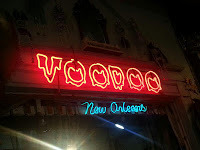 New Orleans and the United States. Slaves were forced into servitude, we know, and one way they kept their souls and individuality was through their language and their religion.
New Orleans and the United States. Slaves were forced into servitude, we know, and one way they kept their souls and individuality was through their language and their religion.Papa Doc—Haiti’s despot dictator—had a great deal to do with Voodoo appearing to be some kind of black magic practice in which the dead were awakened and brought to life in zombie form to perform ghastly deeds. And with more zeal than Papa Doc—the movies stepped in to make the practice appear to be secret and menacing! I don’t pretend to really understand the practice of religion; I did meet once with a
 Voodoo priestess on Rampart Street who gave me a sense of the beliefs and practices which don’t always seem exceptionally strange—Catholic saints were adopted into the religion and having grown up with such beliefs, I do get a feeling with altars and the way one can ask others to help them when they’re asking for help and intervention with their prayers.
Voodoo priestess on Rampart Street who gave me a sense of the beliefs and practices which don’t always seem exceptionally strange—Catholic saints were adopted into the religion and having grown up with such beliefs, I do get a feeling with altars and the way one can ask others to help them when they’re asking for help and intervention with their prayers. As in modern wiccan practices, Louisiana Voodoo or New Orleans Voodoo also looks to herbs and spells. Gris-gris bags can be created for protection and luck. Since Hollywood so managed to turn Voodoo into something creepy and to be feared, you can also buy many things in the local shops you might want to associate with
 something underground and perhaps a bit magical and dark. Yes, you can buy a chicken foot talisman. But, remember, there are people out there shopping who are buying votive candles just as Catholics buy votive candles.
something underground and perhaps a bit magical and dark. Yes, you can buy a chicken foot talisman. But, remember, there are people out there shopping who are buying votive candles just as Catholics buy votive candles. 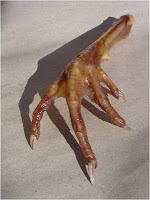 My point here, of course, is not to explain something that I have no real right to explain. Those who are interested can find a wealth of books to study.
My point here, of course, is not to explain something that I have no real right to explain. Those who are interested can find a wealth of books to study.
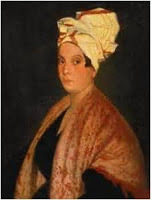 The most famous Voodoo queen of New Orleans was, as most of us have heard, a woman named Marie Laveau. (Remember, you can visit her grave at St. Louis number one, set down your pennies, turn three times, and ask her spirit for luck or favors, if you wish!) Most people believe that like any good priestess, therapist, or spiritual advisor, Marie knew how to listen and use what she learned when giving advice. Today, you can stop by Marie Laveau’s House of Voodoo, a shop where you’ll find handmade and one of a kind items, items associated with the practice of Voodoo, gris-gris bags and more.
The most famous Voodoo queen of New Orleans was, as most of us have heard, a woman named Marie Laveau. (Remember, you can visit her grave at St. Louis number one, set down your pennies, turn three times, and ask her spirit for luck or favors, if you wish!) Most people believe that like any good priestess, therapist, or spiritual advisor, Marie knew how to listen and use what she learned when giving advice. Today, you can stop by Marie Laveau’s House of Voodoo, a shop where you’ll find handmade and one of a kind items, items associated with the practice of Voodoo, gris-gris bags and more.
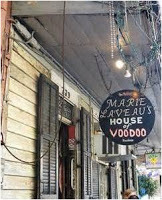 When you visit, please remember, they’re not really into helping you “hex” anyone. Nor would they help you get even with your ex-wife, put a curse on your husband, and go about practicing any kind of incantation to make your enemy’s jaw drop off.
When you visit, please remember, they’re not really into helping you “hex” anyone. Nor would they help you get even with your ex-wife, put a curse on your husband, and go about practicing any kind of incantation to make your enemy’s jaw drop off. What you will find is a shop of wonderful things that are fascinating and interesting. When you make purchases here, you’ll have a special little piece of time and culture. Even if you’re not shopping, the place is atmospheric and fun; I’ve had many friends swear that they weren’t going to buy a thing—and then leave with a bag full of candles, jewelry, masks or maybe religious pieces. You can also purchase shirts and mugs, all kinds of souvenirs. Now, of course, you can buy spell kits. You’re more than welcome to cast spells—hopefully, good spells. Love spells, or spells to help you move forward in your job—maybe make peace with a troubling relative. There are fun little dolls, interesting potions, and more. No one says you can’t have a little fun! Marie Laveau’s House of Voodoo can be found at 739 Bourbon Street. You can also
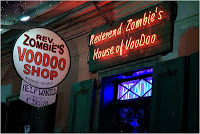 visit Reverend Zombie’s House of Voodoo at 723 St. Peter Street, and/or Voodoo Authentica of New Orleans Cultural Center and Collection at 612 Dumaine Street. It’s interesting, and very good I think, for those who don’t practice Voodoo to learn about Voodoo; it’s always great when we understand and respect what others embrace. Hey, most of have beliefs that seem strange to those of other faiths! There are more little shops and shops that carry Voodoo paraphernalia while they concentrate in other directions.
visit Reverend Zombie’s House of Voodoo at 723 St. Peter Street, and/or Voodoo Authentica of New Orleans Cultural Center and Collection at 612 Dumaine Street. It’s interesting, and very good I think, for those who don’t practice Voodoo to learn about Voodoo; it’s always great when we understand and respect what others embrace. Hey, most of have beliefs that seem strange to those of other faiths! There are more little shops and shops that carry Voodoo paraphernalia while they concentrate in other directions.Of course, we’re talking New Orleans, so there is more that is different here, more that is seen as occult. I have friends who consider themselves practicing vampires. While I’ve seen travel shows about groups and cults that really drink blood, this isn’t what is practiced by my friends. They consider themselves to be “spiritual” vampires; they “drink” energy and life from the air and the earth.
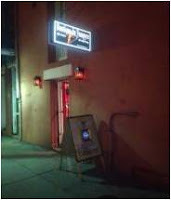
 One of my personal favorite shops in the city is the Boutique du Vampyre. You’ll find this at 709 and 1/2 St. Ann. This shop is owned by a friend of mine but trust me—that’s not why you want to come. You will love the unique merchandise. Beautiful, custom, locally made jewelry, candles, vampire hunter game boxes, custom fangs, perfumes, dolls—special dolls, as a matter of fact. You can get your “Vampire Worry Dolls” here. The shop has beautiful, fun, and amazing merchandise. I say—go! The city is, of course, filled with Voodoo shops and the unusual and I encourage you to step into all the doorways that intrigue you. Shopping is fun here because yes, while you can find the chain stores (nothing wrong with them) you can also find people who delight in what they do and sell, are experts in what they do and sell, and enjoy being as unique as possible.
One of my personal favorite shops in the city is the Boutique du Vampyre. You’ll find this at 709 and 1/2 St. Ann. This shop is owned by a friend of mine but trust me—that’s not why you want to come. You will love the unique merchandise. Beautiful, custom, locally made jewelry, candles, vampire hunter game boxes, custom fangs, perfumes, dolls—special dolls, as a matter of fact. You can get your “Vampire Worry Dolls” here. The shop has beautiful, fun, and amazing merchandise. I say—go! The city is, of course, filled with Voodoo shops and the unusual and I encourage you to step into all the doorways that intrigue you. Shopping is fun here because yes, while you can find the chain stores (nothing wrong with them) you can also find people who delight in what they do and sell, are experts in what they do and sell, and enjoy being as unique as possible.

Two more I suggest that are fun—Hex, Old World Witchery—is at 1219 Decatur. Beautiful things! (Actually, there is an “original” in another great city, Salem, Mass.) And feel like a cup of tea along with a “reading?” Leaves, tarot, palm. Lovely store, great coffee and tea, and easy-going atmosphere. These will all be found at Bottom of the Cup Tea Room, 327 Chartres Street. It’s just about
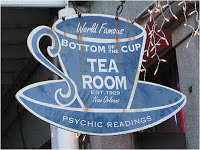 right across from the W on Chartres Street—after or before your cup of tea,
right across from the W on Chartres Street—after or before your cup of tea,
Published on April 16, 2013 04:28
April 13, 2013
30 Days of Why I Love New Orleans - Day 17
Jambalaya Jubilee-ing, French Quarter Fest-ing, Bent Pages—and Strawberries!
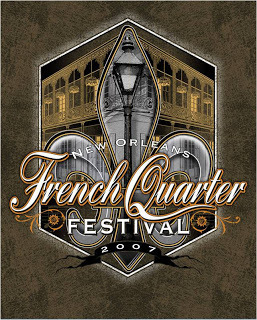 Spring comes around, springs-up, so to say (very bad pun) every year. Spring means you can get set for the French Quarter Fest—one of the largest free music festivals in the country. There’s something as fresh and fun as the spring season about the Fest—you walk around, you see stands with wonderful and incredible goodies to eat, you see all kinds of performers. It’s still spring so the dead heat of summer hasn’t set in, and if you’re a music lover in any way, it will put a spring in your step! There’s one thing, of course, that founders ask—don’t bring in food and drink, buy it there. They want it to stay free for all, and they need sponsors—those selling food and wares along the way—to be able to keep it up.
Spring comes around, springs-up, so to say (very bad pun) every year. Spring means you can get set for the French Quarter Fest—one of the largest free music festivals in the country. There’s something as fresh and fun as the spring season about the Fest—you walk around, you see stands with wonderful and incredible goodies to eat, you see all kinds of performers. It’s still spring so the dead heat of summer hasn’t set in, and if you’re a music lover in any way, it will put a spring in your step! There’s one thing, of course, that founders ask—don’t bring in food and drink, buy it there. They want it to stay free for all, and they need sponsors—those selling food and wares along the way—to be able to keep it up.Walk on down by the river—you’ll find stages, booths, food, drink . . . great things. Art! Fun, you name it. But it’s called the French Quarter Fest—and the French Quarter is all about being involved. The date may be a bit different each year, so you always need to look it up—just
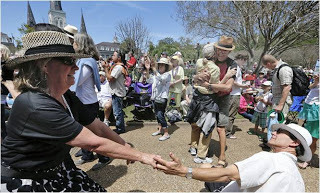 key in French Quarter Fest for whatever year and you can get the low-down. Around the city, hotels and bars get in on the action and you can go just about anywhere and hear a special group. Many places have French Quarter Festival specials on their drink and food menus and it’s really—let the good times roll!
key in French Quarter Fest for whatever year and you can get the low-down. Around the city, hotels and bars get in on the action and you can go just about anywhere and hear a special group. Many places have French Quarter Festival specials on their drink and food menus and it’s really—let the good times roll!So, the city also gets busy, crazy; sometimes a bit high on room prices. What do you do, what do you do? Well, you could plan to come in and enjoy a wonderful day of music, food, and spring festing—then take a side trip. Head out to Houma, Louisiana. It just takes about an hour. Houma is where you’ll find Bent Pages. And the Jambalaya Jubilee. The Jambalaya Jubilee Writers Conference is in association with the Nicholls State College and the Terrebonne Parish Library. It’s a day filled with panels and speeches and the organizers bring in some of the most renowned and popular authors today and they run the gamut on the written word—from local to International authors, fiction and non-fiction, children’s books, homespun books, thrillers, you name it. Every year, you’ll find a new roster and a few favorites they’ve been so nice to, they just can’t get rid of them. (Like me.)
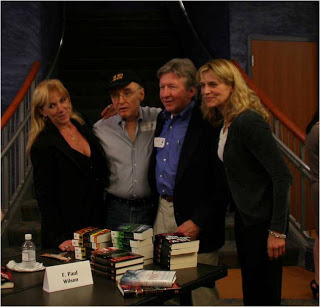
Yes . . . they have a Louisianian Idol—that’s where you turn in a few pages of a work in progress and have it read—and critiqued by a panel of editors, agents and an author or two. While you’re in Houma, of course, you must stop by Bent Pages. It’s run by some of the most wonderful booksellers in the world—and possibly the world’s most unusual booksellers as well! In a world where we are increasingly turning to the Internet for songs and music and book stores are on the demise, Bent Pages is a precious and unique gem.
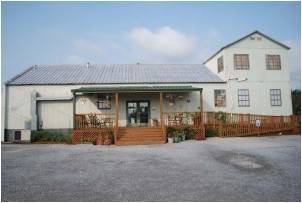
Houma, the Jubilee, and Bent Pages are on the route out of the city on the Lower Mississippi Plantation route so it’s not all that far out of the way if you’re exploring, learning more about Cajun history, or seeking out bayou and environmental tours. Bent Pages bookstore can be found at 1422 Barrow Street in Houma. There’s a charming porch that surrounds the front of the store with rocking chairs so you can grab your ‘maybe’ purchases and sit in the cool shade and rock while going through them. First, of course, you can buy your coffee and tea or soup and sandwich in the café. Nothing run of the mill here; the café is as one-of-a-kind as the
 shop. Great coffee!
shop. Great coffee!Every month, dozens and dozens of people drive in from all over the area to pick up big bags of books; Molly and Kay are readers and they know their clientele and are trusted to pick out reading material for others. This doesn’t mean that they don’t like strangers. They know authors, they know books, and if they don’t know something, they’ll find out for you. This is a place where it’s just really pleasant to be. Down home hospitality exists.
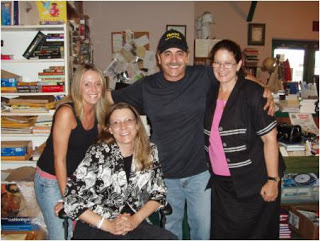 But, please, remember your manners. This is not a chain. If you like to pull out books and just dump them on the chairs or other bookshelves. Molly will politely remind you that if you’re in a bookstore, you can probably read, and if you can read, you know that C comes after B, and therefore you should know how to re-shelve a book! Molly is very matter-of-fact. But, she’ll also happily do a lot more digging for you, play charades while trying to help you figure out an author or a book, and go way above and beyond the usual. There is nowhere in the world you can go that is quite like Bent Pages, in all kinds of great and amazing ways! For authors and readers--they run the most amazing book signings you can imagine. There’s something about home and comfort and all good things here. Obviously you don’t need a special date to stop by a book store, but for the French
But, please, remember your manners. This is not a chain. If you like to pull out books and just dump them on the chairs or other bookshelves. Molly will politely remind you that if you’re in a bookstore, you can probably read, and if you can read, you know that C comes after B, and therefore you should know how to re-shelve a book! Molly is very matter-of-fact. But, she’ll also happily do a lot more digging for you, play charades while trying to help you figure out an author or a book, and go way above and beyond the usual. There is nowhere in the world you can go that is quite like Bent Pages, in all kinds of great and amazing ways! For authors and readers--they run the most amazing book signings you can imagine. There’s something about home and comfort and all good things here. Obviously you don’t need a special date to stop by a book store, but for the French
 Quarter Fest and the Jambalaya Jubilee, you can check it all out on line—they try to coincide every year.
Quarter Fest and the Jambalaya Jubilee, you can check it all out on line—they try to coincide every year. While all this is happening in NOLA and Houma, there’s also a terrific and yummy thing happening in the opposite direction, but still, not all that far. It’s the Ponchatoula Strawberry Festival. So let’s say you could start out hearing some great music and enjoying wonderful food, arts, and crafts at the French Quarter Festival, then drive on out to Houma and enjoy the book world. There are lovely places outside the city to stay. Then, you could drive on back to the city, maybe see some more music and head out the opposite way to take part in the delicious craziness of the Strawberry Festival.
 But any time you want to head to New Orleans, pop on line and find out what is going on. The state loves festivals, music, art, food, and books. There are many special events that take place during the year. If spring has sprung, however . . . .
But any time you want to head to New Orleans, pop on line and find out what is going on. The state loves festivals, music, art, food, and books. There are many special events that take place during the year. If spring has sprung, however . . . .Ya’all come on down, you hear?
Published on April 13, 2013 14:23
April 11, 2013
30 Days of Why I Love New Orleans - Day 16
The Historical Wax Museum of New Orleans Musee Conti
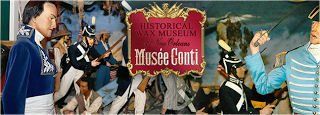
I have a love/hate relationship with wax museums. I’m not all that big on the ones that show you images of current stars and those departed. (Yes, I admit, I have had a
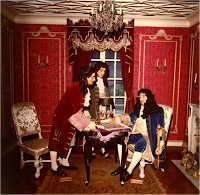 picture taken with wax figures.) But my real love is a wax museum that takes you through history and gives you the great and the traumatic events that shaped us into what we are. (Okay, I also love—love, love, love, a good chamber of horrors!) I believe that I’d be absolutely terrified if I were locked tight in a wax museum—certain that the figures would come to life and do me in.
picture taken with wax figures.) But my real love is a wax museum that takes you through history and gives you the great and the traumatic events that shaped us into what we are. (Okay, I also love—love, love, love, a good chamber of horrors!) I believe that I’d be absolutely terrified if I were locked tight in a wax museum—certain that the figures would come to life and do me in. They stare with sightless eyes, and yet we believe that they see. They are cast in various stages rld we now know. That said, in broad daylight, and with friends, I am fascinated by these museums in which we see these creations that are human—and not! The Historical Wax Museum of New Orleans, Musee Conti, doesn’t set out to terrify you or delight you with images of our current ‘hot’ stars of the silver screen. What it does do is show you the history of a city—New Orleans.
It’s not a huge museum; you can see it in an hour or linger a little longer. It’s
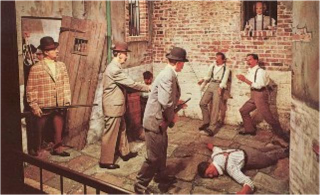 wonderfully unique; the plan here is to tell a story, a specific story.
wonderfully unique; the plan here is to tell a story, a specific story.The Musee Conti is right on Conti (as the name would imply! Number 917, Rue Conti!) in the French Quarter—easy walking distance from most FQ hotels or bed and breakfast places. There are, they say, 154 figures. The tableaus in which they stand were carefully researched. The wax is beeswax—it’s added to a chemical compound. Eyes are imported from Germany and the human hair is imported from Italy. Tremendous care was and is given to the figures.
The museum, I believe, is something that writers and readers and anyone who has a love for the city would enjoy seeing—especially because of the specific stories it relates. There are tableaus that tell a tale of the people who came and made a difference in the city of
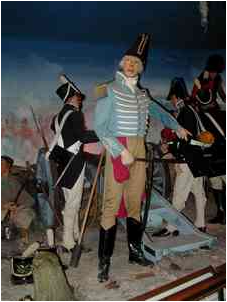 New Orleans. We all know about Andrew Jackson and the Battle of New Orleans. If history didn’t snare us all as children, school principal Jimmy Driftwood managed to do so with his song. (Look it up on youtube if you haven’t heard it—best version Johnny Horton’s 1959 number 1 hit!) And yes, you’ll find Andrew Jackson here—of course. He was incredibly important to the city of New Orleans, the parish—Louisiana and our country!
New Orleans. We all know about Andrew Jackson and the Battle of New Orleans. If history didn’t snare us all as children, school principal Jimmy Driftwood managed to do so with his song. (Look it up on youtube if you haven’t heard it—best version Johnny Horton’s 1959 number 1 hit!) And yes, you’ll find Andrew Jackson here—of course. He was incredibly important to the city of New Orleans, the parish—Louisiana and our country!But the history of the Battle of New Orleans isn’t all that you’ll find here—it’s a great place to get started at the beginning of NOLA and come all the way through. You’ll have been on Iberville and Bienville and you’ll get to meet these men as they first came through the Louisiana swamps. You’ll get to see scenes that show voodoo priestesses and explain the real religious practice.
Arrrrh! Matey! Naturally, you’ll meet the Lafitte pirates here and learn more about them—the lives they led before and after the famous battle, and how pirates wound up with Andrew Jackson.
And you’ll see more, too, as history moves on. The wax museum to me is wonderful
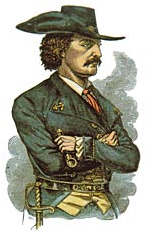 in that it depicts the high points of history, but doesn’t deny it. (You might have realized by now that I really hate white-washed history. Own up, man! That’s how we try to prevent hatred, war, and prejudice from rearing their cruel heads again!)
in that it depicts the high points of history, but doesn’t deny it. (You might have realized by now that I really hate white-washed history. Own up, man! That’s how we try to prevent hatred, war, and prejudice from rearing their cruel heads again!)The good—you’ll get to see some great jazz figures and others prominent in music, art, literature, and sports who called the city home or came to New Orleans to add their indelible touch to the wonderful city.
Something that I think that’s interesting here is that the figures were so thoroughly researched; you may see an historical figure you assumed to be a tall, strapping man—only to see that he seems somewhat short and tiny. That’s because, in the research that was done, artists relied on much more than a portrait to recreate their man (or woman!) You’ll see these people as they were, to the absolute best that careful historical delving could afford. And from what I’ve read on some of the subjects here, they’re pretty much so right on the nose. Noses. Yes, in wax.
I love the place. It can—like most of the plantations we’ve talked about!—be rented for all kinds of events. Showers, rehearsal dinners, Christmas parties, you name it. Of course, it’s not a bed and breakfast—but they cater to all kinds of affairs and also, naturally, to school groups.
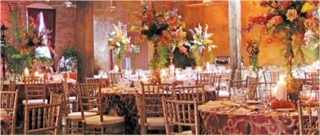 If you decide to go, please make sure you call and check on the hours. Right now, to the best of my knowledge, it’s open Mondays, Fridays, and Saturdays, from 10:00AM to 4:00PM. But, if you happen to be in the city on different days and really need to get in there—or if you have a group—you can call and try to set up an appointment. Also, for parties,
If you decide to go, please make sure you call and check on the hours. Right now, to the best of my knowledge, it’s open Mondays, Fridays, and Saturdays, from 10:00AM to 4:00PM. But, if you happen to be in the city on different days and really need to get in there—or if you have a group—you can call and try to set up an appointment. Also, for parties, make sure you give yourself some leeway.
Oh, wait! I think I said that I love (love, love, etc.) a good chamber of horrors. While the Musee Conti sets out to tell history and does it exceptionally well, it does offer a Haunted Dungeon!
Ahha! So there. (Chills and thrills!)
If you have a chance, love history, love wax figures and excellent tableaus, try to find the time and get down there to see it. You can do so on Monday, Friday, or Saturday morning or afternoon, and save the rest of the day for another unique NOLA experience!
Because it’s not open every day, you can call and check what’s going on at 504-525-2605. Their party rooms are absolutely lovely, too.
Immerse yourself!
And watch their eyes . . . .
Maybe even envision the lights being out and the figures coming to life and . . . .
Doesn’t have to be creepy! Imagine how cool it would be if you could sit down and have a conversation with Andrew Jackson!
Published on April 11, 2013 00:21
April 10, 2013
30 Days of Why I Love New Orleans - Day 15
Music and All That Jazz
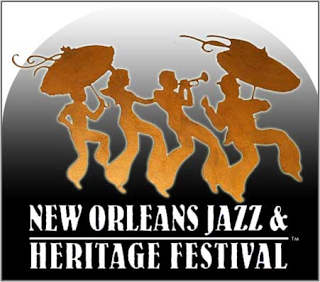 First of all, if you can make it, one of the most remarkable events of the year in Nola is New Orleans Jazz and Heritage Festival that takes place for ten days in spring. (You can still make it this year!)
First of all, if you can make it, one of the most remarkable events of the year in Nola is New Orleans Jazz and Heritage Festival that takes place for ten days in spring. (You can still make it this year!) In my humble opinion, there is nothing quite like it. Nola loves jazz, and Jazz Fest takes it all to a new level. Thousands of bands, thousands of people, local culture and cuisine, parades—a party unlike anything you’ll ever witness or experience anywhere else.
Perhaps it’s all because of the curious beginnings. Unlike many things in NOLA, Jazz Fest does not go back hundreds of years! Many groups had jazz fest during the 1960s but it was 1970 when George Wein
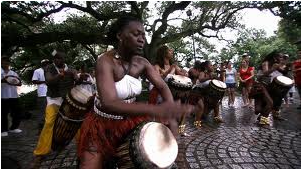 was brought in. He’d already started a few jazz festivals, so he knew what he was doing. And he did. He didn’t head down Bourbon Street, he found the best performers he could in the city by going to the local venues—and even asking musicians in he had seen playing on the street. Mahalia Jackson attended that New Orleans Heritage Fair in Congo Square. She began to sing, and while there were about 350 attendees to the fest that first year, it blossomed into
was brought in. He’d already started a few jazz festivals, so he knew what he was doing. And he did. He didn’t head down Bourbon Street, he found the best performers he could in the city by going to the local venues—and even asking musicians in he had seen playing on the street. Mahalia Jackson attended that New Orleans Heritage Fair in Congo Square. She began to sing, and while there were about 350 attendees to the fest that first year, it blossomed into  something magnificent immediately. Duke Ellington was there, Al Hirt was there . . . the festival was something that sprang to life with an essence all its own and has since blossomed into one of the finest examples of such an event to be found anywhere. Music, food, art, vendors, concerts, culture, and Mardi Gras “Indians,” all come together to fill the air and the city with jazz. Now, there’s an International Pavilion, there are the biggest names in the music industry, and no matter where the performers come from, they become essentially part of the city while Jazz Fest goes on and it now stretches out for ten days, taking in two weekends.
something magnificent immediately. Duke Ellington was there, Al Hirt was there . . . the festival was something that sprang to life with an essence all its own and has since blossomed into one of the finest examples of such an event to be found anywhere. Music, food, art, vendors, concerts, culture, and Mardi Gras “Indians,” all come together to fill the air and the city with jazz. Now, there’s an International Pavilion, there are the biggest names in the music industry, and no matter where the performers come from, they become essentially part of the city while Jazz Fest goes on and it now stretches out for ten days, taking in two weekends. I don’t think there’s anything quite like it anywhere. If you’re ever able to attend, you should. (Unless you hate music!)
Yes, the city gets crazy. And there’s actually a different kind of crazy for Mardi Gras and Jazz Fest. Both are unique here. Will hotel prices go up? Yes. Should you book well ahead? You bet! I especially love Jazz Fest because my sister went
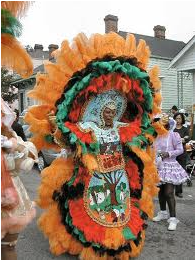 with co-workers from Delta Airlines every year and, she told me once, it was something that really kept them all going. Trust me—if you go once, you’re going to want to go again.
with co-workers from Delta Airlines every year and, she told me once, it was something that really kept them all going. Trust me—if you go once, you’re going to want to go again.However, if you can’t make Jazz Fest and want to go to NOLA at a different time of year, fear not. You will find jazz.
There are a number of restaurants where you can go for a jazz brunch. One fun and lovely place we’ve been often is the Court of Two Sisters. (For some reason, I spent years trying to make it the Court of Three Sisters, but no, there were just two.) As mentioned in “Food!” there really were two sisters who once had a “notions” shop here but now it’s a lovely and historic building where they serve up a jazz brunch on Sundays that is wonderful. There’s a courtyard where, if the weather in nice, you you can get a real feel of the ambiance. There’s a nice big buffet,
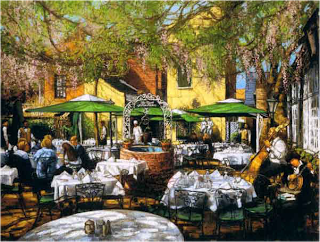 friendly service, the charm of the traditional courtyard, and—jazz.
friendly service, the charm of the traditional courtyard, and—jazz.Another favorite of mine where you’ll get a charming group of three walking around to entertain you while you dine is Muriel’s. The entertainers are delightful and the menu is delicious. If you go, make sure you walk around and see the whole restaurant while you’re listening.
These are just two of the venues. Many, many places do jazz brunch. And while I just mentioned my favorites, you may come with your own—and then look down your nose at me if you choose because you’ve found something you like sooo much better!
I’ve gone to New Orleans often as long as I can remember. After Katrina, so much was down that the city performers and club and restaurant owners were desperate to get people back into the city. Now, I’m a Journey fan, but it did seem that at first that as you walked along, every club there had a group doing Journey. On Bourbon, you’re still going to
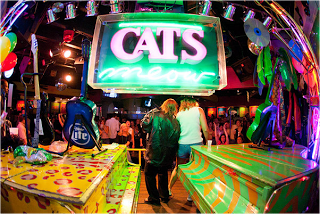 find a bit more of what we all know (and do love.) With years having passed now, I’m thrilled to say that even on Bourbon, you’ll now find jazz and blues. And if you’ve never been to NOLA, you do have to walk down Bourbon Street just so that you can see the fun and craziness and of course, you’ve been on Bourbon Street. You can catch great acts here—and if you want to “music” it yourself, you can drop into “The Cat’s Meow,” a karaoke club. It gets busy and crazy so drop your song in fast!
find a bit more of what we all know (and do love.) With years having passed now, I’m thrilled to say that even on Bourbon, you’ll now find jazz and blues. And if you’ve never been to NOLA, you do have to walk down Bourbon Street just so that you can see the fun and craziness and of course, you’ve been on Bourbon Street. You can catch great acts here—and if you want to “music” it yourself, you can drop into “The Cat’s Meow,” a karaoke club. It gets busy and crazy so drop your song in fast!That having been said, my favorite place to head for music is Frenchman Street. Here you’ll find all kinds of great little atmospheric clubs. You’ll hear the up and coming—yes, yes, you know that name, you love them! You’ll also hear the new groups, the local groups, starting out. And what’s wonderful is that so much of it is so good, in later years you’ll be able to say, “Wow! They’re huge now and I saw them when they were at that little place on Frenchman.”
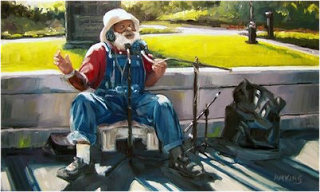
Whether they become huge or not, the great thing is that you’ll hear exceptionally fine musicians and get a sense of the local music scene. Blue Nile (532 Frenchman Street) is one of my favorite places to go, but if you head out at night and start there, walk on down Frenchman. I’m not saying you can’t go wrong—just that it will be hard to do so!
Nice, upscale, with a bit of the British Isles? I say try the Bombay Club. That’s in the French Quarter at 830 Conti Street.
Also, check out Preservation Hall—and the Preservation Hall Jazz Band.
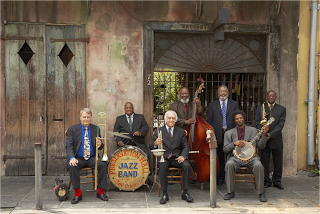 Preservation Hall was formed in the early sixties to see that, well, jazz was preserved. And the band! Wow.
Preservation Hall was formed in the early sixties to see that, well, jazz was preserved. And the band! Wow.But, no matter where you go, you’ll find music. Here’s the amazing thing about New Orleans. Music is everywhere. There’s a gentleman who plays on Royal Street who has been there as long as I can remember. He’s a one-man band, with stringed instruments, a harmonica, a washboard, and more. He’ll sing a Broadway tune, slip into a blues number, and then regale you with a pop number. You don’t have to pay to see him—though, of course, there’s a guitar case in front of him so that you can donate for the pleasure of hearing him. The thing is—he’s a finer musician than many I’ve paid a great deal to see and his voice is fantastic.
Published on April 10, 2013 07:04



